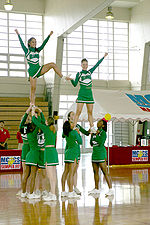Human pyramid: Difference between revisions
→Spain: tidy up |
Tag: section blanking |
||
| Line 31: | Line 31: | ||
[[Image:Cheerleaders.jpg|thumb|right|150px|Cheerleaders warming up for competition]] |
[[Image:Cheerleaders.jpg|thumb|right|150px|Cheerleaders warming up for competition]] |
||
[[Cheerleader]]s may perform human pyramids with more difficult [[stunt]] sequences and [[gymnastics]] incorporated into routines. In cheerleading, pyramids are multiple groups of stunts connected aerially by the flyers. This connection may be made by simple linking of hands or having a multi-level pyramid. The flyers already in the air act as primary bases for another flyer or flyers on top of them. |
[[Cheerleader]]s may perform human pyramids with more difficult [[stunt]] sequences and [[gymnastics]] incorporated into routines. In cheerleading, pyramids are multiple groups of stunts connected aerially by the flyers. This connection may be made by simple linking of hands or having a multi-level pyramid. The flyers already in the air act as primary bases for another flyer or flyers on top of them. |
||
==Dangers== |
|||
Human pyramids can be dangerous. The higher a pyramid grows, the more weight is put upon the shoulders of the first level's participants, and any pyramid over 10 levels high will have enough weight to crush and kill anyone on the lower levels.{{Citation needed|date=May 2010}} |
|||
There is also a great risk of falling from those on higher levels, as pyramids also lose stability with every level. |
|||
== References == |
== References == |
||
Revision as of 07:35, 14 February 2011
This article possibly contains original research. (May 2010) |

A human pyramid is a type of stunt in which several participants stand or kneel together in a row or other formation, forming a base for another tier of participants who stand or kneel on their shoulders, backs or thighs. Successively smaller tiers of participants may be added, each tier supported by the one below it. Lighter participants are placed at the top of the formation, while the strongest participants form the base of the pyramid.
Human pyramids may be performed by cheerleaders, by circus acrobats—who may perform additional tricks simultaneously, such as juggling or making the pyramid travel—or less perfectly by amateurs (often for the fun of failing and falling).
Traditions involving human pyramids

China
- Human pyramids are often formed to reach for the bun during the Chinese Bun Festival.
India
- During the Hindu festival Krishna Janmashtami in Maharashtra, young men form human pyramids to reach pots filled with curd and butter and suspended high above the ground as part of the Dahi Handi ritual.
Spain
- Algemesí holds a Human Pyramid Festival annually on September 8 as a component of thee Fiesta de La Virgen de la Salud (Virgin of Good Health). The muixeranga, or acrobats, form the human towers.[1]
- The castellers of Catalonia form human pyramids up to ten men high. In Catalonia, a statue in the Rambles Nova commemorates the castellers, or human pyramid builders. For example, in Tarragona acrobats form human towers during the Santa Tecla Festival in September and during the Sant Magi festival, held annually in mid-August.[2]
United Kingdom
- The world record for most participants in a human pyramid is 15 men, as held by Chichester High School 6th Form.[citation needed] The school has a long tradition of human "pyramiding" dating back to early Tudor times.
United States
- It is used in bonding, e.g. as part of a North American college fraternity hazing ritual, or in a variation called a spanking pyramid, suitable as a collective punishment, in which the pledges, often divested, are paddled on the conveniently protruded posterior.
- Boy Scouts and Girl Scouts may hold competitions where the patrol that builds a human pyramid using all the scouts in their patrol the fastest, wins.[3]
Cheerleading

Cheerleaders may perform human pyramids with more difficult stunt sequences and gymnastics incorporated into routines. In cheerleading, pyramids are multiple groups of stunts connected aerially by the flyers. This connection may be made by simple linking of hands or having a multi-level pyramid. The flyers already in the air act as primary bases for another flyer or flyers on top of them.
